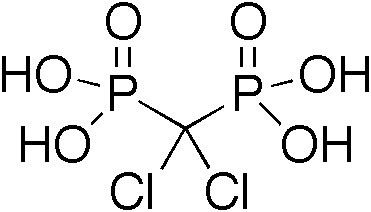ATC code M05BA02 (WHO) PubChem CID 25419 ChemSpider 23731 | CAS Number 10596-23-3 DrugBank DB00720 Molar mass 244.892 g/mol | |
 | ||
AHFS/Drugs.com International Drug Names | ||
Clodronic acid (INN) or clodronate disodium (USAN) is a first generation (non-nitrogenous) bisphosphonate. It is an anti-osteoporotic drug approved for the prevention and treatment of osteoporosis in post-menopausal women and men to reduce vertebral fractures, hyperparathyroidism, hypercalcemia in malignancy, multiple myeloma and fracture related pain because of its potent anti-inflammatory and analgesic effects shown as a reduction in inflammatory markers like IL-1β, IL-6, and TNF-alfa. While bisphosphonates are shown to be effective in reducing vertebral fractures and pain, their role in improving overall survival remains unclear.
Contents
An Italian study compared the analgesic effect of clodronic acid versus acetaminophen in rheumatic condition related pain. Study result show a reduction in pain in favor of clodronic acid that provided more analgesia than 3 grams/day of acetaminophen. Clodronic acid is also used in experimental medicine to selectively deplete macrophages.
Clodronic acid is approved for human use in Canada and Australia, the United Kingdom, where it is marketed as Bonefos, Loron, Clodron and in Italy as Clasteon, Difosfonal, Osteostab and several generics. In other countries is prescribed as a bone resorption inhibitor and antihypercalcemic agent. It is not approved for use in the United States, because it has too many adverse effects.
Use in equine medicine
Clodronic acid is approved for use in horses under the trade name Osphos, for treatment of bone resorptive processes of navicular syndrome. It is given by intramuscular injection at one point in time, with the total dose divided into 2-3 sites on the horse. Clinical effects (e.g. improvement of lameness) after a single treatment can be seen up to 6 months post-treatment.
Adverse reactions and contraindications
Clodronic acid has been shown to have several adverse effects. These include:
